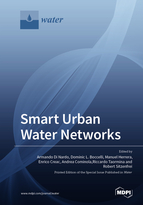Smart Urban Water Networks
A special issue of Water (ISSN 2073-4441). This special issue belongs to the section "Urban Water Management".
Deadline for manuscript submissions: closed (31 January 2021) | Viewed by 91462
Special Issue Editors
Interests: water network management; water network partitioning; water leakage; complex network theory; critical infrastructure; optimization; smart water network; resilience
Special Issues, Collections and Topics in MDPI journals
Interests: urban water infrastructure; drinking water distribution networks; real-time modeling; water security; water quality; decision support; uncertainty analysis
Interests: network analysis; industrial statistics; digital water; infrastructure resilience; complex systems
Special Issues, Collections and Topics in MDPI journals
Interests: water distribution modelling; urban drainage modelling; real-time control; sediment transport in sewers; sustainable solutions for urban drainage systems; flood control in urban areas
Special Issues, Collections and Topics in MDPI journals
Interests: digitization of water systems; demand-side management; water–energy nexus, smart metering, non-intrusive load monitoring, data-driven behavior modelling; anomaly detection; water conservation
Special Issues, Collections and Topics in MDPI journals
Interests: urban water infrastructure, digital water, smart urban water networks, artificial intelligence, machine learning, data science, cyber-physical security, cyber-physical systems, cyber-security
Interests: resilience; modelling of urban water networks; complex network analysis; transition modelling; smart water city; data driven methods
Special Issues, Collections and Topics in MDPI journals
Special Issue Information
Dear Colleagues,
The deployment of digital information and communication technology (ICT) in different assets of urban life has contributed to generating the notion of the Smart City, recently recognized in the scientific and technical international community (Chourabi et al. 2012) as a city where the use of ICT allows making “the critical infrastructure components and services—which include city administration, education, healthcare, public safety, real estate, transportation and utilities—more intelligent, interconnected and efficient” (Washburn et al. 2010).
The development of new monitoring and control sensor technologies and the recent growth of computational power used by simulation software have changed the traditional paradigms to analyze, design, and manage water distribution systems (WDSs) towards data-driven approaches fed by big sensor data (Lambert 2002). The availability of low-cost monitoring and management devices, controlled by remote systems, is pushing WDSs to fill the technological gap with other network utilities, such as electricity, gas, Internet, etc. This transition of WDSs pushed by ICTs has also generated the new concept of the smart water network (SWAN) as a key subsystem of the Smart City.
Further, in the more general framework of Industry 4.0, the recent development of Internet of Things (IoT) technologies applied to smart-grids opens novel opportunities in the management of water network systems and beyond.
At the current state, it is possible to imagine novel solutions based on these innovations to study, analyze, protect, and improve on some traditional challenges in water distribution systems, such as water losses, pressure management, optimal maintenance, water protection from accidental and intentional contamination, network calibration, water use identification, water demand modelling and management, water network partitioning, adaptive and dynamic control, etc., as well as new challenges raised in the digital era (e.g., cyber-security), thus transforming the traditional operational criteria and contributing to an increase in the resilience of urban water systems. In addition, novel concepts by cross-linking the urban water infrastructure to other fields like energy grids, urban drainage, smart homes, etc. can enable the integrated Smart City.
The objective of this Special Issue is to gather contributions advancing scientific and technical methodologies, technologies, and best practices that can be applied with the implementation of actual computational power in simulation, IoT systems, and smart meter devices. Through this open access journal, this will show, to a wide community of researchers, operators, and water utilities, the possibilities to significantly improve some operational problems of water distribution networks by coupling ICT technologies and physically-based mathematical procedures and data-driven techniques such as identification, optimization, complex network theory, etc. This will foster the digitization of urban water networks towards the realization of the vision of smart cities and societies.
Prof. Armando Di Nardo
Prof. Dominic L. Boccelli
Dr. Manuel Herrera
Prof. Enrico Creaco
Prof. Andrea Cominola
Dr. Riccardo Taormina
Prof. Robert Sitzenfrei
Guest Editors
Manuscript Submission Information
Manuscripts should be submitted online at www.mdpi.com by registering and logging in to this website. Once you are registered, click here to go to the submission form. Manuscripts can be submitted until the deadline. All submissions that pass pre-check are peer-reviewed. Accepted papers will be published continuously in the journal (as soon as accepted) and will be listed together on the special issue website. Research articles, review articles as well as short communications are invited. For planned papers, a title and short abstract (about 100 words) can be sent to the Editorial Office for announcement on this website.
Submitted manuscripts should not have been published previously, nor be under consideration for publication elsewhere (except conference proceedings papers). All manuscripts are thoroughly refereed through a single-blind peer-review process. A guide for authors and other relevant information for submission of manuscripts is available on the Instructions for Authors page. Water is an international peer-reviewed open access semimonthly journal published by MDPI.
Please visit the Instructions for Authors page before submitting a manuscript. The Article Processing Charge (APC) for publication in this open access journal is 2600 CHF (Swiss Francs). Submitted papers should be well formatted and use good English. Authors may use MDPI's English editing service prior to publication or during author revisions.
Keywords
- innovative methodologies, techniques and technology for smart water systems
- optimal network design and management
- innovative modeling approaches for smart urban water network
- application of IoT in smart urban water systems
- adaptive control of urban water network
- big data for water utilities management
- identification and disaggregation of water demand
- divide-and-conquer techniques for water network partitioning
- innovative metrics for resilience computation in smart water networks
- actions to protect water distribution networks from accidental and intentional contamination
- water safety plan in urban water systems
- residential water demand management
- data-driven water demand modeling
- non-intrusive load monitoring
- water and energy nexus
- end use disaggregation of water consumption
- water demand user profiling
- behavioral modeling
- energy demand management
- machine learning and big data for urban water systems
- decision support systems for smart urban water
- hydroinformatic applications in water distribution networks
- innovative intermittent uses in drought periods
- pump and turbine (PAT)
- pricing and tariff policing for water uses
- cyber-security of urban water networks










